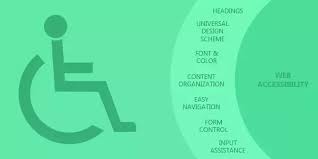Contribute
| Improving Accessibility To Web Services |
Chrissy Jones
09/25/2019
Improving Accessibility to Web Services Improving online user accessibility and making websites inclusive for all is becoming more and more important in the technological age. People are much more reliant on technology now to get everyday things done, which involves accessing a range of different services. So whether it be for shopping, online training, paying bills or simply just connecting with others, for all of these needs and more, it is now common practice to turn to the Web. What does ‘accessibility’ entail? Designing websites that are accessible and inclusive for all is not only essential, it is now a legal right, meaning that online firms who do not provide basic accessibility standards could face a lawsuit under the Americans with Disabilities Act. The definition of ‘Accessibility’ according to a 2013 report from McAfee is the ability to access the data you need from anywhere, across all networks and under any environmental conditions. For example, a hearing-impaired user should be able to move from one network to another without losing accessibility to instructional subtitling. Catering for a range of different user needs Online accessibility should be designed with a range of different disabilities in mind such as hearing, visual, motor and cognitive. This means providing alternative ways of accessing information on a website that caters for all individual disabilities and access requirements. Some examples include proving alt-text that can read images and icons, being able to enlarge text and icons, supporting keyboard navigation which allows users to access information without the use of a mouse, or providing devices that can recognise sign language. The basic idea in this sense is to provide different input and output methods to cater for all. Examples of user accessibility functions The most important aspect of online accessibility is to make sure that content is accessible, and alternative access methods are in place for the whole spectrum of different user needs. This could include providing transcripts for video content that users can download, adding subtitling to videos or providing text alternatives for any non-text based content on your site. Providing a link to a text only version of your website is a comprehensive approach that would tick a lot of boxes. Access for the visually impaired Many users with visual impairments will gravitate towards websites that have high-contrast web browsers and screen readers, using assistive technology that will substitute CSS styles with a set of rules that are designed with the intention of removing any visual barriers to access. This means that one important way to make your website accessible to the visually impaired is to make sure that the most important information on your site is delivered separately from CSS files. Displaying data in a user-friendly way Filling in forms can be tricky for many users. To improve accessibility, information should always be provided in a clear and simple way that can be understood by all users, and all information fields should be clearly labelled, so the user can see exactly the labels that correspond with each field. Website designers should also limit the use of tables. While they can be useful for people with assistive technology to interpret a lot of data, their usage should be restricted only to tabular data. As presenting other information in tables such as lists or layouts could be confusing to screen readers.
You may also access this article through our web-site http://www.lokvani.com/
